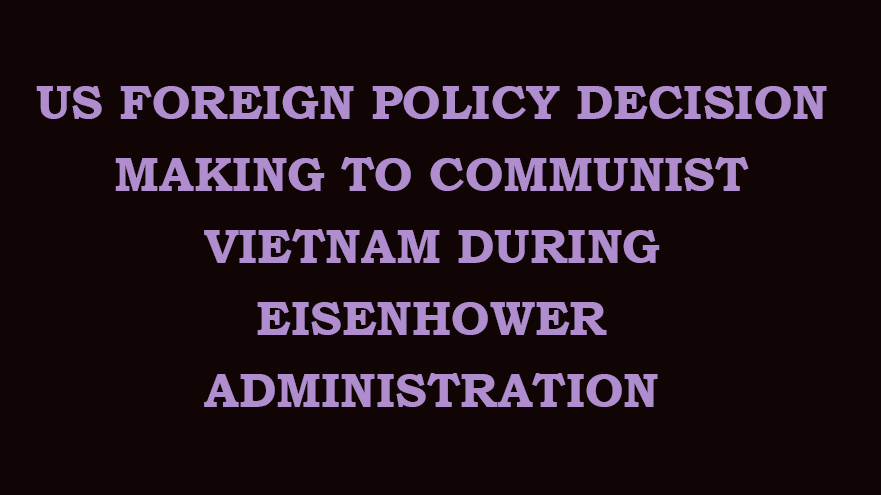
US FOREIGN POLICY DECISION MAKING TO COMMUNIST VIETNAM DURING EISENHOWER ADMINISTRATION
The NSC 48/5 of May 17, 1951 stated that the most immediate overt threats to the U.S. security were presented in Asia. Hence the major U.S. objectives in the area were development by nations of Asia stable, non-communist governments which could maintain internal security and withstand communist influence and prevent aggression, elimination of the preponderant power and influence of the USSR in Asia and securing for the U.S. and the rest of the ‘free world’ and denying to the communist world the material resources of Asia (See PP. DOD ed. Bk. 8. PP. 426-28). Gradually Indochina especially Vietnam began to be viewed as the most sensitive area in Asian. The NSC 124/2 of June 25, 1952 agreed that if China intervened in the French-Vietminh war the U.S. would have to send naval and air units to defend Indochina and would have to consider the possibility of naval and air operation against China itself. By 1953 the U.S. began to favor a military victory against the Vietminh communist forces in Vietnam. The U.S. was ready to make arrangements with the Associated States of Indochina and other interested states of the area to continue the war without the French, if they had accepted an unsatisfactory settlement with the Vietminh (See PP. Gravel ed. Vol. I. PP 385-86, 90-92; DSB. October 12, 1953. PP. 486-87)
On March 5, 1954 President Eisenhower approved the NSC 5412 report titled “National Security Council Directive on Covert Operations”. According to the report covert operations had to be designed for creating and exploiting difficult problems for international communism damaging the relations between the USSR and communist China and between them and their allies, retarding the growth of military and economic potential of the Soviet bloc and complicating control within the communist states. Covert operations had to be conducted for discrediting the prestige and reducing the strength and control of international communism throughout the world and strengthening the orientation of the nations of the ‘free world’ towards the U.S. and increasing their capacity to resist international communism. Moreover, the threat of any forces sympathetic to the communist control of a ‘free world’ nation had to be resisted, underground resistance had to be created and overt and guerilla operations had to be promoted in areas controlled or threatened by international communism (See W.C. Gibbons. The U.S. Government and the Vietnam War: Executive and Legislative Roles and Relationships. Part II. 1961 – 1964. Princeton: Princeton University Press, 1986. PP. 308-309)
On August 12, 1954 the NSC report titled “Review of U.S. policy in the Far East” was approved. It called for reducing the power of China in Asia even at the risk of war. The U.S. had to protect its position and restore its prestige in the Far East through a new initiative in Southeast Asia in order to prevent further losses to communism. Hence the U.S. should negotiate a Southeast Asia security treaty which would not limit the U.S. freedom for using nuclear weapons or for stationing U.S. forces in Southeast Asia and which would provide a legal basis to the President to order attack on communist China if it committed armed aggression endangering the interests of the U.S. Moreover, if the U.S. was requested by a legitimate local government of Southeast Asia which needed assistance for defeating local communist subversion or rebellion the U.S. should not only give all the possible overt and covert support within the executive branch authority but also that the President should immediately consider requesting Congressional authority for taking appropriate action which would if necessary include the use of U.S. military forces either locally or against the external source of such subversion or rebellion. Regarding Indochina the report said that the U.S. should make every possible effort for defeating the communist aggression and influence in order to maintain friendly non-communist governments in Cambodia, Laos and South Vietnam and to prevent a communist victory through all Vietnam elections. The U.S. should urge the French to recognize the independence of Cambodia, Laos and South Vietnam and deal directly with the governments of those countries whenever advantageous to the U.S. Moreover the U.S. had to aid the emigration of the people from North Vietnam and their settlement in South Vietnam who were unwilling to live under the communist rule. It was decided that the U.S. support all these policies through the conduct of a “large and effective” scale covert operations (See PP. DOD ed. Bk.10. PP.731-741)
The Southeast policy of the U.S. in the aftermath of Geneva Conference was focused on organizing collective defense against further inroads of communism. It was hoped that the existence of an alliance system would deter communist “aggression” in the region. Thus, South Asia Treaty Organization (SEATO) came into existence as a result of the Southeast Asia Collective Defense Treaty (Manila Pact) of September 8, 1954. Its members were U.S., Britain, France, Australia, New Zealand, the Philippines, Thailand and Pakistan. Each party of the treaty recognized that “aggression by means of armed attack in the Treaty area against any of the parties by unanimous agreement may hereafter designate, would endanger its own peace and safety and agrees that it will in that event act to meet the common danger in accordance with its constitutional process” (American Foreign Policy: Basic Documents. 1950-1955. Washington D.C.: U.S. G.P.O. Vol. I. P.913).
According to the U.S. understanding the provision of the treaty applied only to “communist aggression”. The members of SEATO’s protection to Cambodia, Laos and South Vietnam through protocol to the treaty (For details see appendix III). Through SEATO, the U.S. resolved to prevent any further communist expansion in Southeast Asia and planned to transform Vietnam into a key redoubt in the implementation of its containment policy. Hence in Late September, 1954 the U.S. stopped considering the French as middleman in all its assistance for Vietnam and began to deal directly with Diem, his government and his armed forces (PP. Gravel ed. Vol. I. P.181. For discussion on SEATO see R.H. Fifield. Southeast Asia in United States Policy. New York: Frederick A Praeger Inc., 1963. PP. 113-137). Thus U.S. objective was an independent, non-communist South Vietnam. Thus, having convinced that the loss of South Vietnam would lead to the loss of Southeast Asia during the post Geneva Conference period, the Eisenhower Administration committed itself to build up a strong South Vietnam. Thus, the NSC 5612 of 1956 directed (the U.S. agencies) that the U.S. assist South Vietnam to develop a strong, stable and constitutional government for enabling it to assert an attractive contrast to the conditions in North Vietnam and also to work toward the weakening of the communist in North and South Vietnam for reunifying Vietnam under an anti-communist leadership) PP. Gravel ed. Vol. I.P.267).
The Kennedy Administration took more forthright anti-communist orientation, President Kennedy was of the opinion that the Americans were “unwilling to witness or permit the slow undoing of those human rights to which this nation has always committed and to which we are committed today at home and around the world. Let every nation know whether it wishes us well or ill that we shall pay any price, bear the burden, meet any hardship, support any friend, oppose any foe, to assure the survival and success of liberty” (PPP. John F. Kennedy. 1961. Washington D.C: U.S. G.P.O. P.1).
He was also bent upon “the system’s survival and success, regardless of the cost and regardless of the peril (Ibid. P. 306). Moreover, the events like Khrushchev’s support for the ‘wars of national liberation’, Kennedy’s meeting with Khrushchev in Vienna, the setbacks in Cuba and Laos, all increased the importance of taking a firm stand elsewhere. The American resolve to meet the communist had to be demonstrated at a place where there existed an obvious communist challenge to the American interests. The Kennedy Administration believed that the abandonment of American commitment in Vietnam would be harmful to the American position in Southeast Asia. The Administration agreed that Vietnam was the suitable place to make a stand. Vietnam was considered as an opportunity to demonstrate the American determination to defend “free” countries against the ‘wars of national liberation’. Thus, in order to prevent the loss of South Vietnam to communism, the U.S. decided to increase its military commitments in South Vietnam.
The action orientation of the Johnson Administration was just a constitution of that of the Kennedy Administration. The Johnson Administration oriented its actions towards attaining the objective of an independent, non-communist South Vietnam. The Administration aimed at proving that communist “aggression” would not succeed and that the cost of the “aggression” the communists would have to pay was too high. During the Nixon Administration the basic U.S. objective was still an independent non-communist South Vietnam.
The action-orientations of various Administrations towards the situation in Vietnam resulted in the corresponding foreign policy actions in Vietnam. The American foreign policy in Vietnam war 1950-1975 is dealt with the following section.



